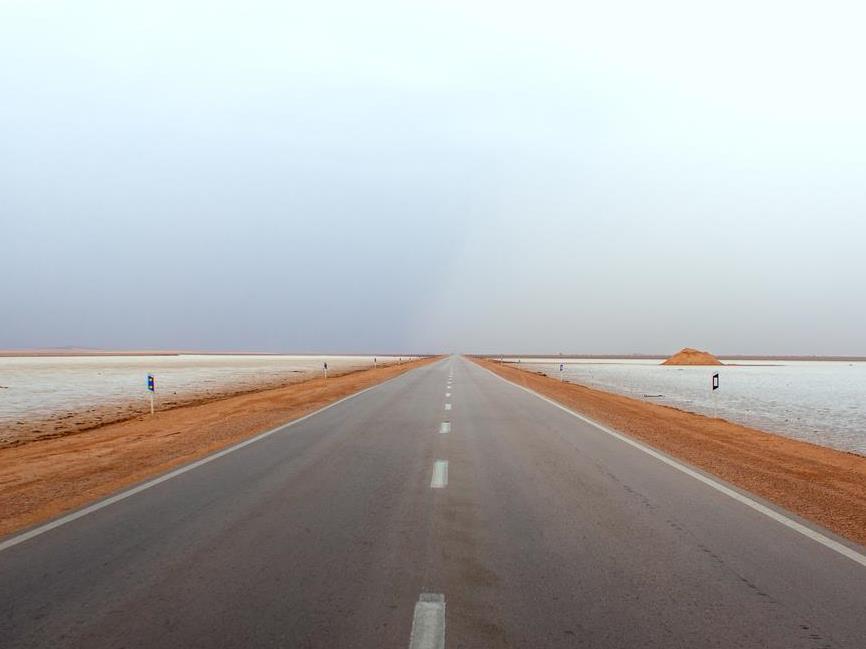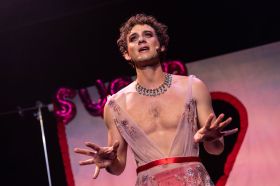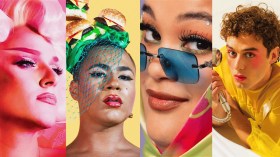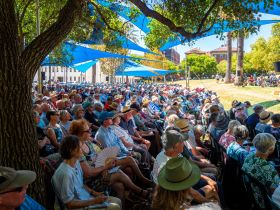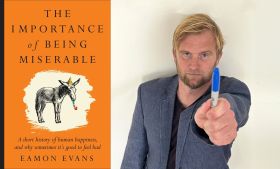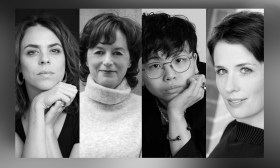Image: Shutterstock.com
The 2016-17 Australia Council for the Arts Annual Report was tabled earlier this week (23 October). It comes midway through the Council’s 2014-19 Strategic Plan, A Culturally Ambitious Nation, which recalibrated its goals and aims for the arts, much of which was focused how Council received and administered funding.
Chair Rupert Myer AO states: ‘2016-17 has been the culmination of Council’s transformation in the way it delivers support to the arts, secures new arts investment and develops the evidence base for the arts. This has been achieved through a period of reform, which has impacted every area of the organisation.’
Have the changes impacted in a positive way, and how did the big picture affect the grass roots this past year?

While funding by location loosely reflects demographics, initiatives overseas were funded more than those at home; image courtesy 2016-2017 Australia Council Annual Report.
What was new in 2016-2017
There seem to be few new core agendas rolled out over 2016-2017. Leading them is an enhanced research program made available through the new Arts Nation online platform. With it came a new position of Research Fellow, appointed in January 2017.
Key research data released this past year included: Showcasing Creativity – which reports on First Nations performing arts programming in Australia’s mainstream venues and festivals, published in September 2016; the Local Arts Engagement interactive dashboard that looks at participation at a local regional level, launched in January 2017; Reading the Reader – a survey of Australian reading habits was published in May 2017 in partnership with Macquarie University, and Connecting Australians: Results of the National Arts Participation Survey published in June 2017.
Evaluations were also undertaken in the areas of Disability Action, International engagement and Regional Arts.
Governance also had a face-lift, with the new role, Deputy Chair of the Australia Council Board, created and filled by Lee-Ann Buckskin. Four Board members retired and four new Board members were welcomed: Kate Fielding, Zoe McKenzie, Sam Walsh AO, and Leigh Carmichael.
The peer assessment pool was also refreshed in 2016-17 and now draws on the expertise of 760 experts representing diverse areas of practice from across the country.
The Four Year Funding program replaced the Key Organisations program. Current contractual arrangements for the Key Organisations concluded on 31 December 2016, and $29 million in Four Year Funding contracts commenced in January 2017. For the first time small to medium organisations were assessed alongside the majors for sustained funding.

Breakdown of funding by practice in 2016-2017; courtesy Australia Council Annual Report
Where did the dollars go?
- More than 6,500 new Australian works were supported by the Council this year, which were appreciated by 16.4 million audience members.
- That represents a total investment of more than $177M in the arts through the Council.
- This year the Council received over 5,347 grant applications, and awarded 1,396 grants, including a significant proportion to first time applicants.
- The Council supported 765 individual artists and groups through grants and strategic activity in 2016–17, a total of $14.6M in funding.
- Overall, 631 organisations received funding through the Council in 2016–17, totally $162.5M in funding.
- The Council supported over 590 small to medium organisations through its grants program, strategic activity and government initiatives in 2016–17; total funding $53.6M
- 2016-17 saw more than $13.1M invested in First Nations artists and communities through the Council.
- In 2016–17 the Council invested $28.5M in funding for the arts in regional Australia. One quarter of the 128 successful applicants for the Council’s Four Year Funding program are based in regional or remote areas.
- This year the Council delivered 48 strategic international development initiatives through an investment of more than $2M, and 135 artists and arts workers were directly supported through strategic travel grants, with a further 79 receiving on-the-ground support from the Council.
- 29 artists embarked on Council residencies in 11 cities across Europe, North America and North Asia.
- In 2016–17 the Council delivered on the final year of a four year commitment and $1.3 million in dedicated funding to support artists with disability, delivering $360,000 this year to individuals and groups.
Digging deeper on the numbers
Some of the areas that the Australia Council ramped up its investment in the arts in 2016-2017 were research, regional and remote Australia, First Nations arts, and International visibility. But what are the details behind the numbers?
During 2016-2017, more than 2.1 million people attended 16,862 events that took place in regional and remote Australia, which represents a 15% increase on 2015-16.
These events included 1,705 performances, of which 418 performances were supported with Australia Council project and program funding and 1,271 were regional performances by MPA (Major Performing Arts) companies and Multi Year funded organisations.
In terms of the visual arts, 337 exhibitions were visited by 1.4 million visitors across regional and remote Australia, whilst 345,000 participated in 14,851 workshops and classes.
From local to global, the Council invested $2 million through strategic international activity, which included support for inbound and outbound delegations, international presentations, exchange projects, market representation, capacity building, residencies, scouting and research.
Myer said: ‘More Australian art is being seen and presented through initiatives and programs that strengthened ties with more countries than ever before.’

The Strategic Goal of Australian Art without boarders was a priority in 2016-2017; image courtesy the Australia Council Annual Report.
The Council delivered 48 initiatives that strengthened ties with other countries and provided 532 grants supporting Australian arts and artists to work internationally.
Put another way, it supported more than 400 artists and organisations to present 2,476 performances and exhibitions in 61 countries, attracting 2.4 million attendees. The Council’s report also points to a noticeable growth in engagement with India and China.
In 2016–17 the Council led delegations to 25 international platforms, art fairs and markets in Europe (54%), North America (11%), and Asia (31%), with first time delegations to the Shanghai China International Arts Festival, Berlin Performing Arts Festival, India Art Fair and Kochi Muziris Biennale in India.
The Council also supported 46 inbound international curators, publishers, literary agents, presenters and producers to attend major Australian contemporary arts events in 2016–17.
Of note, the Visiting International Publishers (VIPs) program delivered alongside the Sydney Writers’ Festival in May 2017, engaged 16 international publishers to meet and do business. The report evaluates $3.8 million in rights sales were made directly to attending VIPs and a further $300,000 in sales that arose indirectly through referrals from VIPs.
Addressing another strategic goal, CEO Tony Grybowski said: ‘The Council remains committed to First Nations art and artists as a priority.’
2016-17 saw more than $13.1 million invested in First Nations artists and communities and 1,620 new works created, a number that was doubled thanks to the Four Year funding program commenced in January 2017.
Of the 128 organisations supported, 13% are led by First Nations people and more than 40% of all organisations identified a First Nations arts and culture component to their work.
Among the achievements in 2016-17 was a new partnership with the Macquarie Group to deliver a First Nations Emerging Curator award, the new Red Ochre Award in partnership with Sydney Opera House, and the First Nations Curators Exchange at the 2017 Venice Biennale.
In 2016–17 the Australia Council commissioned the Australian Bureau of Statistics to produce detailed nationally representative data about First Nations peoples’ participation in arts and cultural expression, based on the National Aboriginal and Torres Strait Islander Social Survey (NATSISS).
Council also worked with the Centre for Aboriginal Economic Policy Research at the Australian National University on analysis of the relationship between First Nations arts participation and well-being. The NATSISS data and well-being analysis will be published later in 2017.
Greater leverage is the new future
Grybowski said that developing co-investment opportunities is a major priority for Council. Chair Rupert Myer continued: ‘The Council has continued to further leverage Government investment to build new co-investment partnerships.’
Success stories in 2016-2017 include delivering the first round of the Marten Bequest travelling scholarships on behalf of Perpetual as trustee ($600,000 to be awarded to 12 recipients); introducing a second $50,000 Red Ochre Award supported in partnership with the Sydney Opera House; and The Mordant Family Fellowship with a $40,000 per annual residency over three years, taking an artist to the American Academy in Rome.
The Council also announced a new partnership with the Macquarie Group to deliver a First Nations Emerging Curator Award. The award includes $30,000 and support to attend professional development activities in Australia and internationally. The recipient will also curate an exhibition with the Macquarie Group collection, mentored by senior curators.
‘I am delighted that these programs, including the Australia Council Workplace Giving Program, will contribute over $775,000 to Australian arts, in addition to the $2 million raised through the highly successful 2017 Venice Biennale project,’ said Grybowski.
Venice Commissioner Naomi Milgrom AO led a successful campaign to present Australia’s representation at the Venice Biennale in 2016-2107 period.
Overall the Annual Report reads well, but then all annual reports are what they are, soft propaganda and a platform to promote achievements. The Australia Council has had a remarkable transformation through difficult times in recent years. Confidence in the sector is not fully restored. Yet, this past year’s achievements are a good step forward in doing that.
What appears to be the strongest indicator across this year’s report is an investment by the Council in legacy and sustainability over individual grants – that is, better research, better international profile, better co-investment partnerships and greater attention to First Nations and regional arts practice. It is a strategic investment in ecological change across the arts.

